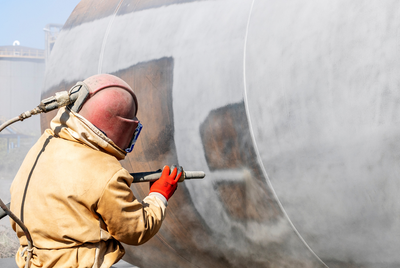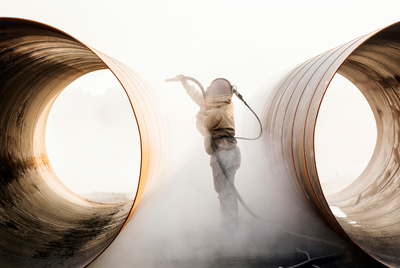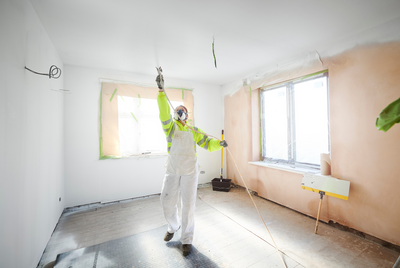24th Apr 2024
Sandblasting has long been a go-to method for cleaning, finishing, and preparing surfaces across various industries. However, the use of traditional beach sand in sandblasting has raised concerns regarding health, safety, and environmental impact. In this blog, we'll explore whether beach sand can be used for sandblasting, why sandblasting is illegal in the UK, and alternative abrasive options that are available.
What is sandblasting?
Sandblasting, an outdated term better known now as abrasive blasting, is a surface preparation and finishing technique used to clean, roughen, or shape surfaces by propelling abrasive materials at high velocity against the surface. First patented in the US by Benjamin Chew Tilghman, he is credited with developing one of the earliest sandblasting processes in the 1870s and laying the foundation for sandblasting as a recognised industrial technique. The idea was then perfected by Thomas Wesley Pangborn, by adding compressed air in 1904. Tilghman's invention quickly gained commercial success and was adopted by various industries for surface preparation, cleaning, and finishing applications, becoming an essential tool in industries such as shipbuilding, metalworking, construction, and manufacturing.
Using beach sand for sandblasting
Using beach sand for sandblasting comes with its issues. Whilst it may seem like a suitable option due to its abundance and affordability, it isn’t recommended for sandblasting for several reasons.
- Beach sand can contain various impurities, which can be harmful to the environment if released during the blasting process. These can contaminate soil and waterways, posing risks to ecosystems.
- Beach sand's variability in composition, size, and shape causes inconsistent blasting and potential equipment harm. Effective abrasive blasting relies on media with precise properties, like hardness and size, for desired surface results. Beach sand often falls short of meeting these requirements, leading to heightened equipment wear and maintenance expenses, reducing efficiency.
- Beach sand may contain silica particles. Sandblasting with silica sand is restricted or prohibited in the UK due to health and safety concerns related to exposure to crystalline silica dust. Silica dust, which is generated when silica sand is used as an abrasive material in sandblasting, can pose significant health risks when inhaled, including respiratory diseases such as silicosis, lung cancer, and other respiratory problems.
In the UK, regulations such as the Control of Substances Hazardous to Health (COSHH) Regulations and the Health and Safety at Work etc. Act 1974 aim to protect workers from exposure to hazardous substances, including silica dust. These regulations set strict exposure limits for silica dust in the workplace and require employers to implement measures to control exposure, such as substitution with safer abrasive materials, engineering controls, personal protective equipment (PPE), and proper ventilation.
Alternatives to using beach sand for sand blasting
As a result of these regulations and the associated health risks, sandblasting with silica sand is therefore illegal within the UK. However, there are alternative materials that are specifically designed for abrasive blasting applications and offer consistent performance, safety, and environmental compliance.
- Garnet: A natural mineral abrasive renowned for its hardness, durability, and minimal dust. It efficiently removes coatings, rust, and contaminants without causing excessive equipment wear.
- Aluminium Oxide: A synthetic abrasive prized for its toughness and adaptability. Suited for diverse blasting tasks, it comes in various particle sizes for achieving different surface finishes.
- Glass Beads: Spherical abrasives crafted from recycled glass, offering eco-friendliness and a smooth, satin-like metal finish. Ideal for delicate blasting jobs where surface damage is a concern.
- Silicon Carbide: A sharp, hard synthetic abrasive favoured for aggressive blasting. Perfect for tackling heavy rust and corrosion on metal surfaces, it comes in various grit sizes to meet blasting needs.
- Steel Grit and Shot: Metallic abrasives derived from recycled steel, renowned for durability and suitability for tough cleaning tasks. Effective for removing stubborn coatings and surface contaminants.
- Plastic Media Abrasives: Non-destructive, reusable abrasives made from plastic granules. Ideal for sensitive surfaces and delicate blasting, available in various shapes and sizes for different surface finishes.
It's essential to select the appropriate abrasive media based on the specific requirements of the blasting application and the material being processed.
Whilst beach sand may seem like a convenient option for sandblasting due to its availability and low cost, it presents significant drawbacks and risks. Its variability in composition, particle size, and shape leads to inconsistent blasting results and potential equipment damage. Moreover, beach sand fails to meet the specific properties required for effective abrasive blasting, such as hardness, size distribution, and shape. Using beach sand as an abrasive media can result in increased wear and tear on blasting equipment, reduced efficiency, and higher maintenance costs. Considering these factors, as well as relevant health regulations and laws, it is clear that beach sand is not a suitable choice for sandblasting, and alternative abrasives should be utilised to ensure optimal results, worker safety, and environmental responsibility.
For more guidance on abrasive blasting, click here.



